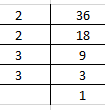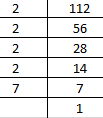The NCERT Solutions for Class 6 Maths Chapter 3 Playing with Numbers Exercise 3.6 explains the method of solving problems related to finding the HCF of a given set of numbers. These NCERT Solutions are prepared by the subject experts at SNS Academy to help students ace the exam. Set of examples are available in the NCERT textbook, before the exercise, to help students get a hold of the concepts. The faculty has followed the same method as of the examples to solve the questions present in the exercise. The solutions are created to help students avoid any sort of confusion that could arise while solving the problems. The exercise-wise problems can be solved and revised by the students with the help of the NCERT Solutions Class 6 Maths Chapter 3 Playing with Numbers Exercise 3.6.
NCERT Solutions for Class 6 Maths Chapter 3 Playing with Numbers Exercise 3.6
Access NCERT Solutions for Class 6 Maths Chapter 3: Playing with Numbers Exercise 3.6
1. Find the HCF of the following numbers:
(a) 18, 48
(b) 30, 42
(c) 18, 60
(d) 27, 63
(e) 36, 84
(f) 34, 102
(g) 70, 105, 175
(h) 91, 112, 49
(i) 18, 54, 81
(j) 12, 45, 75
Solutions:
(a) 18, 48


18 = 2 × 3 × 3
48 = 2 × 2 × 2 × 2 × 3
HCF = 2 × 3 = 6
Therefore, the HCF of 18, 48 is 6
(b) 30, 42


30 = 2 × 3 × 5
42 = 2 × 3 × 7
HCF = 2 × 3 = 6
Therefore, the HCF of 30, 42 is 6
(c) 18, 60


18 = 2 × 3 × 3
60 = 2 × 2 × 3 × 5
HCF = 2 × 3 = 6
Therefore, the HCF of 18, 60 is 6
(d) 27, 63


27 = 3 × 3 × 3
63 = 3 × 3 × 7
HCF = 3 × 3 = 9
Therefore, the HCF of 27, 63 is 9
(e) 36, 84


36 = 2 × 2 × 3 × 3
84 = 2 × 2 × 3 × 7
HCF = 2 × 2 × 3 = 12
Therefore, the HCF of 36, 84 is 12
(f) 34, 102


34 = 2 × 17
102 = 2 × 3 × 17
HCF = 2 × 17 = 34
Therefore, the HCF of 34, 102 is 34
(g) 70, 105, 175



70 = 2 × 5 × 7
105 = 3 × 5 × 7
175 = 5 × 5 × 7
HCF = 5 × 7 = 35
Therefore, the HCF of 70, 105, 175 is 35
(h) 91, 112, 49



91 = 7 × 13
112 = 2 × 2 × 2 × 2 × 7
49 = 7 × 7
HCF = 7
Therefore, the HCF of 91, 112, 49 is 7
(i) 18, 54, 81



18 = 2 × 3 × 3
54 = 2 × 3 × 3 × 3
81 = 3 × 3 × 3 × 3
HCF = 3 × 3 = 9
Therefore, the HCF of 18, 54, 81 is 9
(j) 12, 45, 75



12 = 2 × 2 × 3
45 = 3 × 3 × 5
75 = 3 × 5 × 5
HCF = 3
Therefore, the HCF of 12, 45, 75 is 3
2. What is the HCF of two consecutive
(a) numbers?
(b) even numbers?
(c) odd numbers?
Solutions:
(a) The HCF of two consecutive numbers is 1
Example: The HCF of 2 and 3 is 1
(b) The HCF of two consecutive even numbers is 2
Example: The HCF of 2 and 4 is 2
(c) The HCF of two consecutive odd numbers is 1
Example: The HCF of 3 and 5 is 1
3. HCF of co-prime numbers 4 and 15 was found as follows by factorisation:
4 = 2 × 2 and 15 = 3 × 5 since there is no common prime factor, so HCF of 4 and 15 is 0. Is the answer correct? If not, what is the correct HCF?
Solutions:
No. The answer is not correct. The correct answer is 1.
Access Other Exercise Solutions of Class 6 Maths Chapter 3: Playing with Numbers
Exercise 3.1 Solutions
Exercise 3.2 Solutions
Exercise 3.3 Solutions
Exercise 3.4 Solutions
Exercise 3.5 Solutions
Exercise 3.7 Solutions
Also, explore –
NCERT Solutions for Class 6 Maths Chapter 3
NCERT Solutions for Class 6
NCERT Solutions